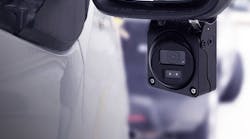Lytx has launched its Surfsight auxiliary cameras to increase visibility on the sides and rear of commercial vehicles, according to a company press release.
Fleets can choose from wrap mount (also known as side cameras) or flush mount (also known as rear cameras) options. The wrap-mount auxiliary camera can be hung on round surfaces such as a vehicle mirror while the flush-mount auxiliary camera is designed to be mounted flush on flat surfaces, such as the back of a vehicle, by drilling it in place.
See also: Lytx solution addresses unsafe truck parking; video telematics integration with DTNA
There are two configuration options for Surfsight auxiliary cameras: wired and Wi-Fi. When installing auxiliary cameras solely on the side near the vehicle mirrors, fleets can choose between the wired and Wi-Fi connectivity options. In an installation set-up that involves different parts of the vehicle (back of the vehicle, cargo, roof, etc.), no matter what the vehicle size is, the wired connectivity method is recommended to ensure connection stability.
While the wired solution is more reliable in obstructed environments and is more expandable as it allows adding more cameras to vehicles over time, the Wi-Fi solution is easier and faster to install and can cut down installation costs per vehicle. Hybrid solutions are currently not supported.
Surflight Auxiliary Cameras are IP69K rated, meaning they are dustproof, waterproof, and can withstand high pressure and steam cleaning. They can operate in a range of temperatures, even in extreme conditions, according to the release.
The Surfsight auxiliary cameras can integrate with the Surfsight dash cam, providing an extended view around the entire vehicle.
This additional visibility can help drivers comply with regulations in different regions, such as the Direct Vision Standard in the U.K.



